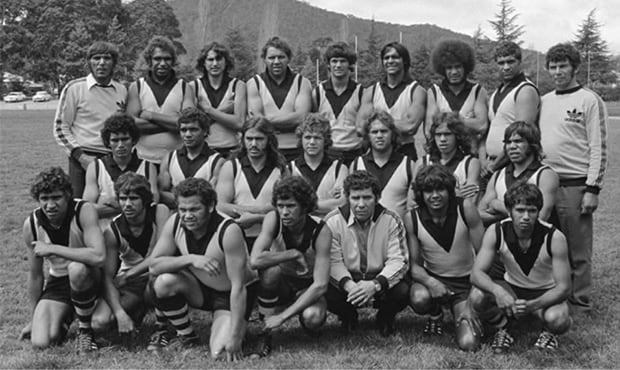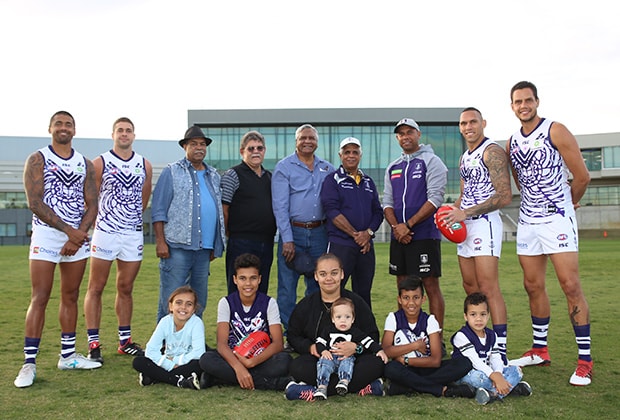- Wilson ready for Indigenous round
- Indigenous Freo player highlights
- Smoking ceremony a 'special' moment
As featured in The Weekend West, Steve Butler writes about a significant photo in WA football history.
The hardened faces of the men who helped shape the AFL have been the centrepiece of culture and respect inside the walls of the Fremantle Dockers this week.
The black-and-white picture of a 1974 all-Aboriginal WA team that played in a national carnival in Canberra ties strongly not only to the current Dockers but to many of the indigenous stars who have added a special excitement to the national game.
This weekend, the AFL is celebrating Aboriginal football in its Sir Doug Nicholls Round, its annual group of fixtures to acknowledge the continuing indigenous contribution to football.
As part of National Reconciliation Week, which coincides with the AFL round and has the theme “Don’t keep history a mystery”, the Dockers have used the photograph and the identification of the men in it as a tool to celebrate indigenous culture and football.
Several of the players in the photograph were welcomed to the club.

The 1974 WA Aboriginal team. Back row: Tom Hayden, Reg Yarran, John Kalen, Phil Narkle, Richard Walley, John McHenry, Michael Indich, Lester Bennel,l Dick Reidy. Middle: Greg Thorn, Allen Narkle, Doug Headland, Lyall Garlett, Clem Rodney, Theo Kearing, Victor Little. Front: Owen Woods, Roger Hayden, Bruce Jacobs, John Hayden, Phil Bennell, Kevin Hill, Rod Collard.

Bradley Hill, Stephen Hill, John Hayden, Lyall Garlett, John McHenry, Roger Hayden Snr, Roger Hayden, Harley Bennell and Michael Johnson with Roger Hayden's children, nephews and nieces.
The team was coached by current player Harley Bennell’s grandfather Phil and in it were uncles of Michael Johnson and brothers Stephen and Bradley Hill, and the father of former star and current assistant coach Roger Hayden.
“To reach out and have them come in is something special because they were the ones who paved the way for us now,” Johnson said of the team, which featured his uncle John McHenry.
“To have the club jump on board is fantastic, not only for myself and the other players, but for our uncles and dads to come back down to see what we do and enjoy this game that we all love.”
Roger Hayden Sr made an immediate response when asked to describe the essence of his 1974 team.
“Hard, mate. There were some big boys in our side,” he said.
He also joked that family ties often helped with the selection of the Aboriginal State team, which offered a rare annual travel treat.
“To get up in an aeroplane was one of the biggest events we used to have back in those days,” he laughed.
“Not too many Noongars got up and flew around the countryside to play footy back in the early ‘70s.”
He said a special legacy had been created by the football offspring from that team by becoming a force throughout the AFL.
“I don’t care if they’re playing for the Dockers or another side, it just gives you that little bit of a kick to know that someone from the family is representing us ... especially the Noongar tribe,” he said.
Roger Hayden Jr said recognition of his father’s team was a fitting tribute to the Reconciliation Week theme.
Ironically, the Canberra carnival was played at Manuka Oval, where he made his AFL debut for the Dockers against North Melbourne in 2002.
“It’s important that the guys who played in that team realise they started something that has basically gone through to today,” Hayden Jr said.
“It’s making sure we’re getting the message out there, understanding what we’ve accomplished over the past few decades and where the Noongar people have come from. The stories that dad and pop and nan told us and all the little things about growing up out in the bush, they are always going to help others understand the way we grew up and how indigenous culture is.
“The AFL has been fantastic in helping indigenous culture and putting the word out about the Stolen Generation and the 1967 referendum, just recognising that the further we go on, the better it is going to get.”
A heritage map produced this week by the AFL Players Association shows that Noongar people make up the biggest representation of Aboriginal tribes in the AFL this season. The map highlights the cultural diversity of the AFL’s indigenous players, with the league’s 83 male players and 10 female players representing 49 cultural and language groups.




